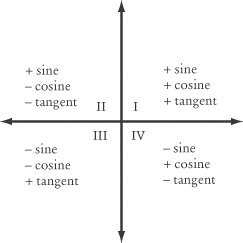Basic Functions and the Right Triangle
If you know the measure of one of the non-right angles in a right triangle, the
trigonometric functions tell you the ratio of the lengths of any two sides of
the triangle.
In the right triangle below, one acute angle is labeled ? and the sides of the triangle are labeled hypotenuse, opposite, and adjacent,
according to their position relative to the angle of measure ? .

Sine
The sine of an angle is the ratio of the side opposite the angle to the
hypotenuse.

Cosine
The cosine of an angle is the ratio of the side adjacent the angle to the
hypotenuse.

Tangent
The tangent of an angle is the ratio of the side opposite the angle to
the side adjacent to the angle.

A handy way to remember these formulas is the acronym SOHCAHTOA. The S,
C, and T stand for the three different basic trigonometric
functions, and the two letters after the S, C, and T refer
to the sides of the triangle that are being related by that function.
SOH:Sine is the side
Opposite the angle divided by the
Hypotenuse.
CAH:Cosine is the side
Adjacent to the angle divided by the
Hypotenuse.
TOA:Tangent is the side
Opposite divided by the
Adjacent side.
Using Your Calculator with the Basic Functions
On some questions dealing with sine, cosine, and tangent, your calculator can be
extremely helpful. Using your calculator, you can quickly compute the value of
one of the three trigonometric functions at any given angle. On a graphing
calculator, find the button indicating the trigonometric function you want to
perform, type in the value of the angle, and then hit Enter. To calculate the
cosine of 45º, press the COS button, then type in 45, and press Enter.
cos45=.707 ....
On non-graphing calculators you may need to type in the value of the angle first
and then press the trigonometric-function button.
Angles Larger than 90º and the Basic Functions
Angles in a right triangle can never be larger than 90º, since the sum of all
three angles must equal 180º. But on the Math IC, you may occasionally run into
angles that are larger than 90º. It is often more intuitive to think of these in
terms of the coordinate plane rather than in terms of a triangle.
Below are pictured four angles in the coordinate plane. The first is the acute
angle we’ve already covered in this chapter; the next three are all larger than
90º.

The four quadrants of the coordinate plane become very important when dealing
with angles that are larger than 90º. Each angle larger than 90º can be
“simplified” by looking at it in the context of its own quadrant. In the figure
below, the four angles from the previous angle are defined in terms of their own
quadrants:

By reconsidering each angle based on its relationship to the x-axis, it
becomes clear that each of the original angles can be treated as a reoriented
30º angle. In other words, a 210º angle is just the same as a 30º angle except
that the 210º angle is in the third quadrant. In terms of the basic
trigonometric functions, this means that the value of a 210º angle is the same
as the value of a 30º angle, except that the sign of the trigonometric function
differs based on the quadrant that the angle is in. Depending on the quadrant of
the coordinate plane in which an angle resides, the values of the trigonometric
properties of that angle will be either positive or negative. Below is a figure
illustrating the signs of the trigonometric functions according to the quadrant
in which they lie.

You should memorize the above graph.
The Math IC will probably test whether you know the proper sign for each
quadrant in an indirect way, meaning that it’s unlikely that you’ll have to do
any heavy calculating when dealing with this topic. Instead, you might find a
question such as:
If the value of sin – ? is .5, what is the value of sin
? ?
This question doesn’t ask you to think about sin for any specific value of
?. Instead, it tests your understanding of the quadrant signs for the sine
function. The first thing you should notice is that –? and ? have the same magnitude, even if they have different signs. This means that the
magnitude of sine for –? and ? will be the same. Immediately you should understand that sin
? must equal either .5 or –.5. To figure out which of these values is right, you
have to decide what quadrant angle ? resides in. Based on the graph of the sine function or from the above chart, you
can see that the sine function has a positive value in quadrants I and II, and
negative values in quadrants III and IV. Since sin –? is equal to a positive number, .5, you know that –?
must represent an angle in quadrant I or II. Since angle ? is ?
across the x-axis, you can see that angle ? must be in either quadrant III or IV. The value of sin
? must be negative: –.5 is the right answer.
Back
Next
Next to display next topic in the chapter.
Mathematics Practice Questions
Video Lessons and 10 Fully Explained Grand Tests
Large number of solved practice MCQ with explanations. Video Lessons and 10 Fully explained Grand/Full Tests.